Horatio Nelson: A Norfolk Hero
by Zoe King
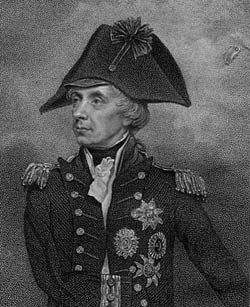 October 2005 saw the 200th Anniversary of the Battle of Trafalgar, and Lord Nelson's death following his victory over the combined naval forces of the French and the Spanish. England is in the grip of Nelson fever, with events planned across the country, but it's in humble surroundings in Norfolk that the story began... October 2005 saw the 200th Anniversary of the Battle of Trafalgar, and Lord Nelson's death following his victory over the combined naval forces of the French and the Spanish. England is in the grip of Nelson fever, with events planned across the country, but it's in humble surroundings in Norfolk that the story began...
As the birthplace of a man second only to Shakespeare in 'The Greatest Ever Englishman' stakes, the village of Burnham Thorpe in North Norfolk wears its fame quietly. The man in question, Horatio Nelson, was born on 29 September 1758 to the village parson and his wife. October 21 2005 marks the 200th Anniversary of the Battle of Trafalgar -- and of course the death of Admiral Nelson on his flagship, Victory -- but though the village welcomes visitors, it does so in restrained fashion. The fact that it is so hidden away in the narrow lanes has probably been its saving grace, so even in this Anniversary year, visitors are relatively few. That's good news for those who do come, as they can spend as much time as they wish wandering around the church and the surrounding lanes in search of the village hero.
Although record has it that Horatio, or Horace as he preferred to be called, was born in the Parsonage House for All Saint's Church where his father was rector, locals still repeat the rumour that he was actually born in the fine brick and flint barn which runs adjacent to the village inn. It is said that his mother, Catherine Suckling, ventured out on a pony cart, and was unable to manage the additional half mile or so back to the vicarage before young Horace put in an appearance, seven weeks prematurely. Even if the story isn't true, the barn is a rare sight indeed and well worth seeing.
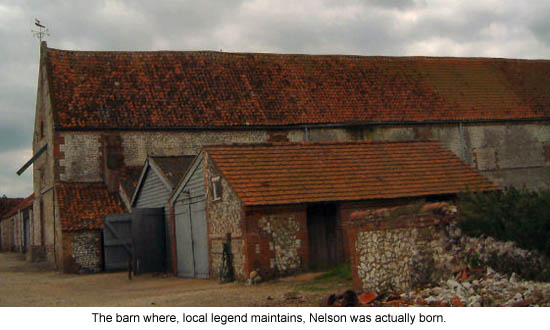
The church itself, which stands in a quiet spot away from the main village, dates to the 13th century and is surrounded by hummocky fields, the result it is thought of villagers firing their houses during the Black Death. A pretty church with some outstanding chequerwork flints on its eastern face, All Saint's is steeped in Nelson history both inside and out. Beyond the door, which bears the notice: 'All who enter of your charity pray latch these doors lest a bird enter and die of thirst', visitors can see the Purbeck marble font in which Horatio was baptised within hours of his birth. (He was very weak and not expected to live.)
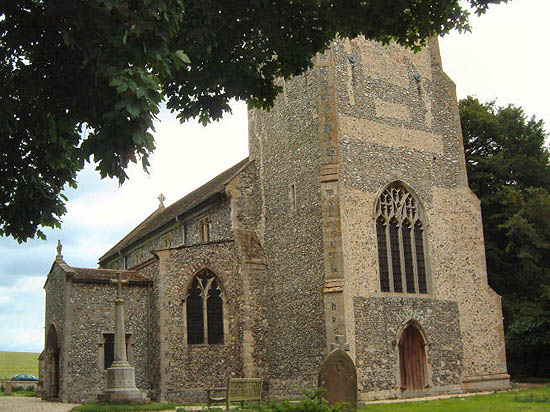
Also worth seeing are the rood cross and lectern, both made from timber brought from HMS Victory, and the contemporary account of Nelson's astonishing state funeral. This was held not in Burnham Thorpe, as he had wished, but in London, by decree of King George III. Other naval artefacts include the crest of the Second World War battleship, HMS Nelson, whose white ensigns are in the western arch of the tower.
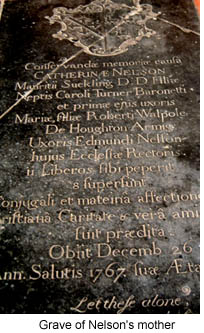 Just in front of the altar can be seen the graves of Nelson's parents; his mother died when Horatio was just nine years old, having, according to Nelson's sister Susannah, 'bred herself to death'. His father died in 1802, and on the north chancel wall above his grave, a bust of his victorious son looks down. A wander around the churchyard outside will reveal the graves of further members of Nelson's family, including brothers Maurice, Edmund, Suckling (named for his mother's family) and George, and sister Susannah. Just in front of the altar can be seen the graves of Nelson's parents; his mother died when Horatio was just nine years old, having, according to Nelson's sister Susannah, 'bred herself to death'. His father died in 1802, and on the north chancel wall above his grave, a bust of his victorious son looks down. A wander around the churchyard outside will reveal the graves of further members of Nelson's family, including brothers Maurice, Edmund, Suckling (named for his mother's family) and George, and sister Susannah.
Opposite the village green is The Lord Nelson public house, which was renamed in honour of the hero in 1807, having formerly been named The Plough. Nelson, then a young captain, gave a farewell dinner at the inn before leaving to take up command of the Agamemnon in February 1793. It is thought he was a regular visitor to the pub, and used the upstairs room to meet his crew before setting sail. The inn has plenty of charm, featuring original settles and decidedly uneven stone floors, and appears more or less untouched since Nelson's time. It is full of artefacts, offering a selection of books and other things for sale. It even serves up its own 'Nelson's Blood', 'a unique blend of 100 proof Navy Rum with Herbs and Spices' made to a secret recipe, and offered to commemorate the return voyage from Spain of Nelson's body.
Perhaps half a mile beyond the village is the lane leading to the site of Nelson's 'official' birthplace, the Parsonage House, which somewhat unaccountably was demolished three years before Nelson's death. It is still possible to see the frigate-shaped pond Nelson dug out in the garden, and a small plaque marks the outer wall, though it is barely readable now.
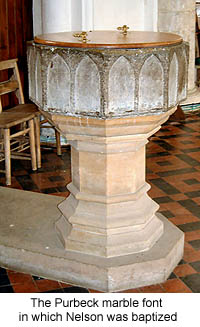 As a boy, Horatio was briefly educated at Norwich's Royal Grammar School, but following the death of his mother in 1768, he and his brother William were transferred to The Paston School, North Walsham, which had a growing reputation as the best school in Norfolk. The headmaster was one John Price Jones, who held court over 60 boarders, charges for whom were '£18 per year for board and education, an entrance fee of two guineas, and thirty shillings per year for washing'. As a boy, Horatio was briefly educated at Norwich's Royal Grammar School, but following the death of his mother in 1768, he and his brother William were transferred to The Paston School, North Walsham, which had a growing reputation as the best school in Norfolk. The headmaster was one John Price Jones, who held court over 60 boarders, charges for whom were '£18 per year for board and education, an entrance fee of two guineas, and thirty shillings per year for washing'.
In addition to 'a firm grounding in Latin and Greek', it is said the young Horatio took sailing lessons while at Paston, on nearby Barton Broad. The fact that his sister Catherine lived at Barton Hall with her husband George Matcham gives credence to this story, as it is known that 'Little Horace' visited relatives while at school. It has to be said though that even this early exposure to sailing didn't prevent the seasickness from which he famously suffered throughout his naval career.
Relics from Nelson's schooldays are still held at the Paston, which is marking the bi-centenary with its own exhibition. Trafalgar 200: Nelson, Paston and North Walsham runs until 23 October 2005. Visitors will be offered a rare opportunity to view the schoolroom where Nelson was educated, and to see the private collection. The school is now known as Paston College, and can be found on Grammar School Road in the town.
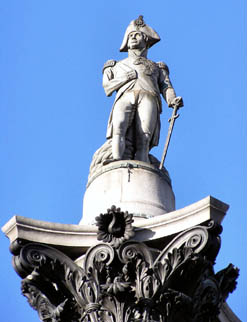 Following the death of Nelson's mother, his uncle, Maurice Suckling, promised that he would get one of the Nelson sons started on a naval career when the time came. 'Little Horace' didn't forget that promise, and when the Falklands Crisis of 1770 arose, he saw it as an opportunity. He begged his brother William to write to their father, asking him to contact Maurice about taking him to sea. His uncle was dubious, given that Horace was such a sickly child, but eventually he agreed, and the boy was signed up to the Navy on New Year's Day, 1771. Following the death of Nelson's mother, his uncle, Maurice Suckling, promised that he would get one of the Nelson sons started on a naval career when the time came. 'Little Horace' didn't forget that promise, and when the Falklands Crisis of 1770 arose, he saw it as an opportunity. He begged his brother William to write to their father, asking him to contact Maurice about taking him to sea. His uncle was dubious, given that Horace was such a sickly child, but eventually he agreed, and the boy was signed up to the Navy on New Year's Day, 1771.
Throughout the years, Nelson remained devoted to his 'beloved Burnham' and returned to live there with his new wife, Fanny, whom he met in Antigua in 1785. He lived there, unemployed and restless, for five years before being appointed captain of Agamemnon in 1793, following the revolutionary French government's declaration of war on Great Britain. That posting marked the turning point in the Captain's career, and he began to establish himself as a brave and innovative commander. But despite his travels, he did not forget his native Norfolk, and returned to Great Yarmouth as a newly promoted Vice Admiral in March, 1801. Great Yarmouth paid its own homage to Nelson by erecting the first 'Nelson's Column' in 1819, predating the Trafalgar Square column by over 20 years. The column is topped not by Nelson, but by Britannia, who stands gazing towards the North-West, and Burnham Thorpe, birthplace of her greatest naval hero.
Related Articles:
- England Expects: Nelson and the Battle of Trafalgar, by Dawn Copeman
- https://www.timetravel-britain.com/articles/history/trafalgar.shtml
More Information:
We regret that we no longer have the resources to maintain up-to-date links and/or hours and pricing details for the various sites and attractions listed on this website. For more information about the location(s) listed above, please use your favorite search engine or visit Wikipedia.
A freelance writer and editor from England, Zoe King is currently
working in Australia on a variety of writing-related projects. She
writes both fiction and non-fiction, and her work has been widely
published. See more at her website: http://www.zoeking.com.
Article and photos © 2005 Zoe King
Trafalgar Square Statue © 2005 Sam Savine
|
